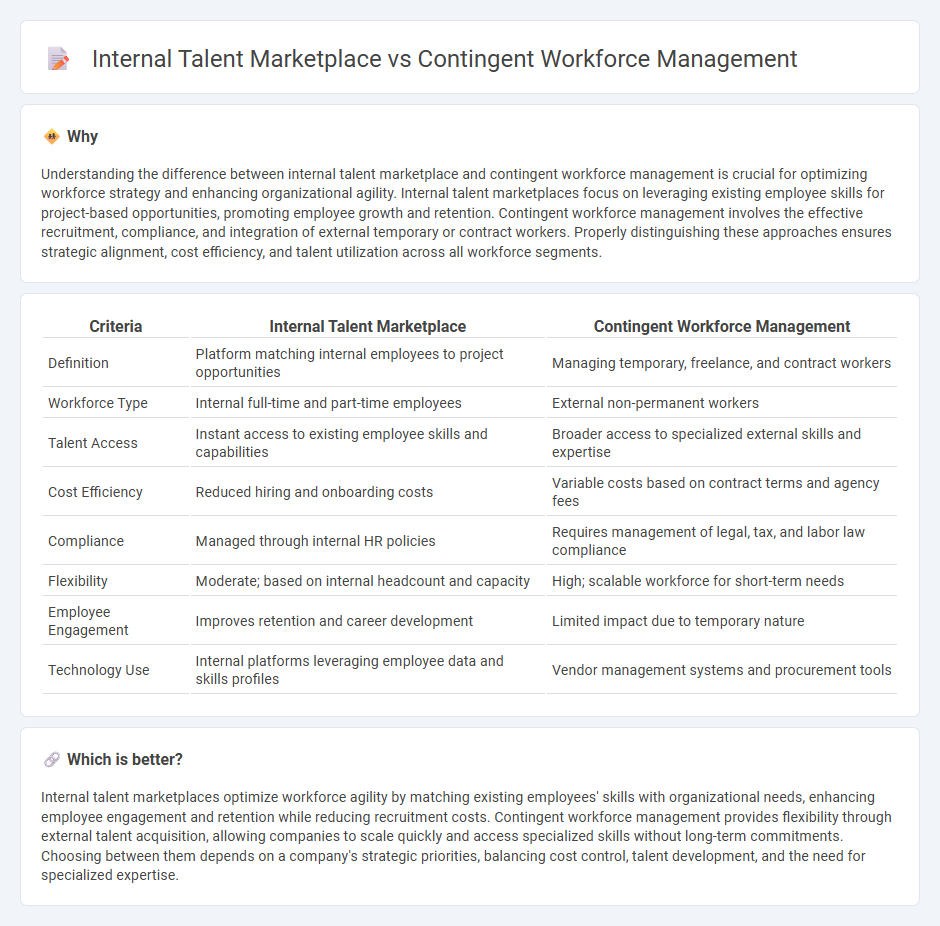
Internal talent marketplaces leverage company-wide skills databases to match employees with project opportunities, promoting career growth and retention. Contingent workforce management focuses on effectively sourcing, onboarding, and overseeing temporary or contract workers to meet fluctuating business demands. Explore how integrating these strategies can optimize workforce agility and talent utilization in your organization.
Why it is important
Understanding the difference between internal talent marketplace and contingent workforce management is crucial for optimizing workforce strategy and enhancing organizational agility. Internal talent marketplaces focus on leveraging existing employee skills for project-based opportunities, promoting employee growth and retention. Contingent workforce management involves the effective recruitment, compliance, and integration of external temporary or contract workers. Properly distinguishing these approaches ensures strategic alignment, cost efficiency, and talent utilization across all workforce segments.
Comparison Table
| Criteria | Internal Talent Marketplace | Contingent Workforce Management |
|---|---|---|
| Definition | Platform matching internal employees to project opportunities | Managing temporary, freelance, and contract workers |
| Workforce Type | Internal full-time and part-time employees | External non-permanent workers |
| Talent Access | Instant access to existing employee skills and capabilities | Broader access to specialized external skills and expertise |
| Cost Efficiency | Reduced hiring and onboarding costs | Variable costs based on contract terms and agency fees |
| Compliance | Managed through internal HR policies | Requires management of legal, tax, and labor law compliance |
| Flexibility | Moderate; based on internal headcount and capacity | High; scalable workforce for short-term needs |
| Employee Engagement | Improves retention and career development | Limited impact due to temporary nature |
| Technology Use | Internal platforms leveraging employee data and skills profiles | Vendor management systems and procurement tools |
Which is better?
Internal talent marketplaces optimize workforce agility by matching existing employees' skills with organizational needs, enhancing employee engagement and retention while reducing recruitment costs. Contingent workforce management provides flexibility through external talent acquisition, allowing companies to scale quickly and access specialized skills without long-term commitments. Choosing between them depends on a company's strategic priorities, balancing cost control, talent development, and the need for specialized expertise.
Connection
Internal talent marketplaces enhance contingent workforce management by providing real-time access to a diverse pool of skills within an organization, enabling efficient allocation of temporary and project-based workers. Leveraging AI-driven platforms, companies can match internal employees with contingent roles, reducing dependency on external contractors while optimizing workforce agility. This integration supports strategic workforce planning and cost management by aligning talent supply with dynamic business demands.
Key Terms
**Contingent Workforce Management:**
Contingent Workforce Management focuses on optimizing the use of temporary, freelance, and contract workers to enhance workforce flexibility and reduce labor costs. It involves processes such as sourcing, compliance, time tracking, and vendor management to ensure efficient deployment of external talent. Explore how a robust contingent workforce management strategy can drive agility and cost-effectiveness in your organization.
Temporary Staffing
Contingent workforce management focuses on optimizing the acquisition, deployment, and oversight of temporary staffing solutions to meet fluctuating business demands efficiently. Internal talent marketplaces leverage existing employee skills and preferences to match temporary assignments within the organization, reducing reliance on external hiring. Explore how integrating these strategies enhances workforce agility and cost-effectiveness in today's dynamic labor markets.
Vendor Management System (VMS)
Contingent workforce management leverages Vendor Management Systems (VMS) to streamline procurement, compliance, and performance tracking of temporary labor, enhancing cost control and operational efficiency. Internal talent marketplaces prioritize matching existing employees' skills with project needs, fostering agility without external vendor involvement. Explore how integrating VMS with internal talent platforms can optimize workforce strategies and drive organizational success.
Source and External Links
Everything You Need to Know About Contingent Workforce - This guide provides insights into the strategic process of sourcing, organizing, and optimizing external workers like independent contractors and temporary workers.
How Does Contingent Workforce Staffing Work? - This article explains the process of recruiting temporary or contract workers on an as-needed basis to fulfill specific roles in a highly volatile labor market.
What is Contingent Workforce Management? - This resource discusses the hiring and managing of non-permanent employees, including temporary agency workers and independent contractors, through strategic approaches like MSP and VMS systems.
 dowidth.com
dowidth.com